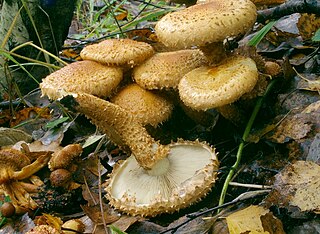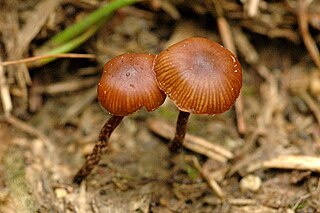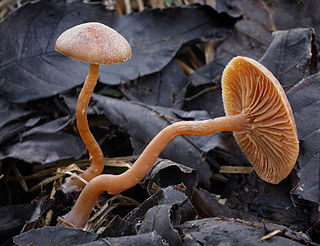Related Research Articles

The Agaricales are an order of fungi in the division Basidiomycota. As originally conceived, the order contained all the agarics, but subsequent research has shown that not all agarics are closely related and some belong in other orders, such as the Russulales and Boletales. Conversely, DNA research has also shown that many non-agarics, including some of the clavarioid fungi and gasteroid fungi belong within the Agaricales. The order has 46 extant families, more than 400 genera, and over 25,000 described species, along with six extinct genera known only from the fossil record. Species in the Agaricales range from the familiar Agaricus bisporus and the deadly Amanita virosa to the coral-like Clavaria zollingeri and bracket-like Fistulina hepatica.

The Strophariaceae are a family of fungi in the order Agaricales. Under an older classification, the family covered 18 genera and 1316 species. The species of Strophariaceae have red-brown to dark brown spore prints, while the spores themselves are smooth and have an apical germ pore. These agarics are also characterized by having a cutis-type pileipellis. Ecologically, all species in this group are saprotrophs, growing on various kinds of decaying organic matter. The family was circumscribed in 1946 by mycologists Rolf Singer and Alexander H. Smith.

The Clavariaceae are a family of fungi in the order Agaricales. Originally the family contained most of the clavarioid fungi, but in its current sense is more restricted, albeit with a greater diversity of basidiocarp forms. Basidiocarps are variously clavarioid or agaricoid (mushroom-shaped), less commonly corticioid or hydnoid.

The Tricholomataceae are a large family of fungi within the order Agaricales. Originally a classic "wastebasket taxon", the family included any white-, yellow-, or pink-spored genera in the Agaricales not already classified as belonging to e.g. the Amanitaceae, Lepiotaceae, Hygrophoraceae, Pluteaceae, or Entolomataceae.

Cuphophyllus is a genus of agaric fungi in the family Hygrophoraceae. Cuphophyllus species belong to a group known as waxcaps in English, sometimes also waxy caps in North America or waxgills in New Zealand. In Europe, Cuphophyllus species are typical of waxcap grasslands, a declining habitat due to changing agricultural practices. As a result, four species, Cuphophyllus atlanticus, C. colemannianus, C. lacmus, and C. lepidopus are of global conservation concern and are listed as "vulnerable" on the IUCN Red List of Threatened Species.

Phaeocollybia is a genus of fungi in the family Hymenogastraceae. They are characterized by producing fruit bodies (mushrooms) with umbonate caps and rough brown spores. The genus is widely distributed, and contains about 50 species. They are known for a long stipe which continues down into the ground, known as a rooting stipe or pseudorhiza formed as the fruitbody grows up from the subterranean colonized roots well below the organic soil layer. The genus is primarily mycorrhizal but may also be somewhat parasitic on forest trees.

Pholiota is a genus of small to medium-sized, fleshy mushrooms in the family Strophariaceae. They are saprobes that typically live on wood. The genus has a widespread distribution, especially in temperate regions, and contains about 150 species.

The Hydnaceae are a family of fungi in the order Cantharellales. Originally the family encompassed all species of fungi that produced basidiocarps having a hymenium consisting of slender, downward-hanging tapering extensions referred to as "spines" or "teeth", whether they were related or not. This artificial but often useful grouping is now more generally called the hydnoid or tooth fungi. In the strict, modern sense, the Hydnaceae are limited to the genus Hydnum and related genera, with basidiocarps having a toothed or poroid hymenium. Species in the family are ectomycorrhizal, forming a mutually beneficial relationship with the roots of trees and other plants. Hydnum repandum is an edible species, commercially collected in some countries and often marketed under the French name pied de mouton.

Mythicomyces is a fungal genus in the family Mythicomycetaceae. A monotypic genus, it contains the single species Mythicomyces corneipes, first described by Elias Fries in 1861. The fungus produces fruit bodies with shiny yellowish-orange to tawny caps that are 1–3 cm (0.4–1.2 in) in diameter. These are supported by stems measuring 2–5.7 cm (0.8–2.2 in) long and 1–2 mm thick. A rare to uncommon species, it is found in northern temperate regions of North America and Europe, where it typically fruits in groups, in wet areas of coniferous forests. There are several species with which M. corneipes might be confused due to a comparable appearance or similar range and habitat, but microscopic characteristics can be used to reliably distinguish between them.

The Inocybaceae are a family of fungi in the order Agaricales, the largest order of mushroom-forming fungi. It is one of the larger families within Agaricales. This family exhibits an ectomycorrhizal ecology. Members of this family have a widespread distribution in tropical and temperate areas.
Limnoperdon is a fungal genus in the monotypic family Limnoperdaceae. The genus is also monotypic, as it contains a single species, the aquatic fungus Limnoperdon incarnatum. The species, described as new to science in 1976, produces fruit bodies that lack specialized structures such as a stem, cap and gills common in mushrooms. Rather, the fruit bodies—described as aquatic or floating puffballs—are small balls of loosely interwoven hyphae. The balls float on the surface of the water above submerged twigs. Experimental observations on the development of the fruit body, based on the growth on the fungus in pure culture, suggest that a thin strand of mycelium tethers the ball above water while it matures. Fruit bodies start out as a tuft of hyphae, then become cup-shaped, and eventually enclose around a single chamber that contains reddish spores. Initially discovered in a marsh in the state of Washington, the fungus has since been collected in Japan, South Africa, and Canada.

Panellus is a genus of more than 50 mushroom species of fungi in the family Mycenaceae as defined molecularly. Prior to molecular analyses the generic name had been used for any white-spored pleurotoid with amyloid spores. Unrelated but similar species are now classified in Sarcomyxa and Scytinotus. In older guides and other literature the type species had been placed in either Pleurotus or Panus and the poroid species had been classified in the synonymous genus Dictyopanus or in broadly defined genera like Polyporus (Polyporaceae) or the more closely allied Favolaschia (Mycenaceae). The closest molecular allies are Resinomycena and Cruentomycena.

Flammulaster is a genus of agaricoid fungi in the family Tubariaceae. It was formerly thought to belong in the family Inocybaceae. The genus has a widespread distribution, and contains 20 species. Flammulaster was circumscribed by American mycologist Franklin Sumner Earle in 1909.

Phaeomarasmius is a genus of fungi in the family Tubariaceae. It was formerly thought to belong in the family Inocybaceae. The genus has a widespread distribution, and contains about 20 species.

Podoserpula is a genus of fungi in the family Amylocorticiaceae. The genus contains two species: the type, P. pusio, commonly known as the pagoda fungus, and the "Barbie pagoda", P. miranda, officially published in 2013. Podoserpula species produce fruit bodies consisting of up to a dozen caps arranged in overlapping shelves, attached to a central axis. Its unique shape is not known to exist in any other fungi. Four varieties of P. pusio are known, which differ in their sizes, spore morphology, and distribution. The genus is known to occur in Australia and New Zealand, Venezuela, Madagascar, and New Caledonia.

Amanita rubrovolvata, commonly known as the red volva amanita, is a species of fungus in the family Amanitaceae. First described scientifically by the Japanese mycologist S. Imai in 1939, it is widely distributed in eastern Asia. The fungus produces small to medium-sized mushrooms, with reddish-orange caps up to 6.5 mm (0.26 in) wide. The stems are up to 100 mm (3.9 in) tall, cream above the ring and cream to yellowish below it. The stem ends in a roughly spherical bulb at the base, which is covered with bright orange patches. Neither edibility nor toxicity have been established for the fungus, but it is suspected to be associated with neurological anomalies. Several molecular studies have confirmed the mushroom's classification in the subgenus Amanita of the genus Amanita, along with closely related species such as A. muscaria.

Deconica is a genus of mushroom-forming fungi in the family Strophariaceae. It was formerly considered synonymous with Psilocybe until molecular studies showed that genus to be polyphyletic, made of two major clades: one containing bluing, hallucinogenic species, the other non-bluing and non-hallucinogenic species. Deconica contains species formerly classified in the sections Deconica and Coprophila of Psilocybe.

Pholiota nubigena, commonly known as the gastroid pholiota or the bubble gum fungus, is a species of secotioid fungus in the family Strophariaceae. It is found in mountainous areas of the western United States, where it grows on rotting conifer wood, often fir logs. It fruits in spring, often under snow, and early summer toward the end of the snowmelt period in high mountain forests. Fruit bodies appear similar to unopened mushrooms, measuring 1–4 centimetres tall with 1–2.4 cm diameter caps that are whitish to brownish. They have a short but distinct whitish stipe that extend through the internal spore mass (gleba) of the fruit body into the cap. The gleba consists of irregular chambers made of contorted gills that are brownish in color. A whitish, cottony partial veil is present in young specimens, but it often disappears in age and does not leave a ring on the stipe.
Flammula is a dark brown-spored genus of mushrooms that cause a decay of trees, on whose bases they often fruit, forming clusters of yellowish brown mushrooms.

The Tubariaceae is a family of basidiomycete fungi described by Alfredo Vizzini in 2008.
References
- ↑ "Episphaeria fraxinicola (Berk. & Broome) Donk 1962". MycoBank. International Mycological Association. Retrieved 2011-03-08.
- 1 2 Kirk PM, Cannon PF, Minter DW, Stalpers JA (2008). Dictionary of the Fungi (10th ed.). Wallingford, UK: CAB International. p. 69. ISBN 978-0-85199-826-8.
- ↑ Berkeley MJ, Broome CE (1875). "Notices of British fungi (1402–1500)". Annals and Magazine of Natural History. 15: 28–41. doi:10.1080/00222937508681018.
- ↑ Kuntze O. (1891). Revisio Generum Plantarum (in German). Vol. 2. Leipzig, Germany: A. Felix. p. 847.
- 1 2 3 4 Rea C. (1922). British Basidiomycetae: A Handbook to the Larger British Fungi. Cambridge, UK: Cambridge University Press. p. 704.
- ↑ Donk MA. (1962). "Notes on Cyphellaceae: 2". Persoonia. 2 (3): 331–48.
- ↑ Singer R. (1986). The Agaricales in Modern Taxonomy (4th ed.). Königstein im Taunus, Germany: Koeltz Scientific Books. ISBN 3-87429-254-1.
- ↑ Moncalvo JM, Vilgalys R, Redhead SA, et al. (2002). "One hundred and seventeen clades of euagarics". Molecular Phylogenetics and Evolution. 23 (3): 357–400. doi:10.1016/S1055-7903(02)00027-1. PMID 12099793.
- ↑ Matheny PB, Curtis JM, Hofstetter V, et al. (2006). "Major clades of Agaricales: a multilocus phylogenetic overview". Mycologia. 98 (6): 982–95. doi:10.3852/mycologia.98.6.982. PMID 17486974.
- ↑ Petersen G, Knudsen H, Seberg O (2010). "Alignment, clade robustness and fungal phylogenetics—Crepidotaceae and sister families revisited". Cladistics. 26 (1): 62–71. doi:10.1111/j.1096-0031.2009.00279.x. PMID 34875756. S2CID 84495351.
- 1 2 Unterseher M, Tal O (2006). "Influence of small scale conditions on the diversity of wood decay fungi in a temperate, mixed deciduous forest canopy". Mycological Research. 110 (2): 169–78. doi:10.1016/j.mycres.2005.08.002. PMID 16388941.
- ↑ "Episphaeria fraxinicola (Berk. & Broome) Donk 1962". GBIF Portal. Global Biodiversity Information Facility. Retrieved 2011-03-08.[ permanent dead link ]
- ↑ Dam N, Dam-Elings M (1991). "Woldmaria crocea new-record and Episphaeria fraxinicola new-record small but nice". Coolia (in Dutch). 34 (1): 22–26.